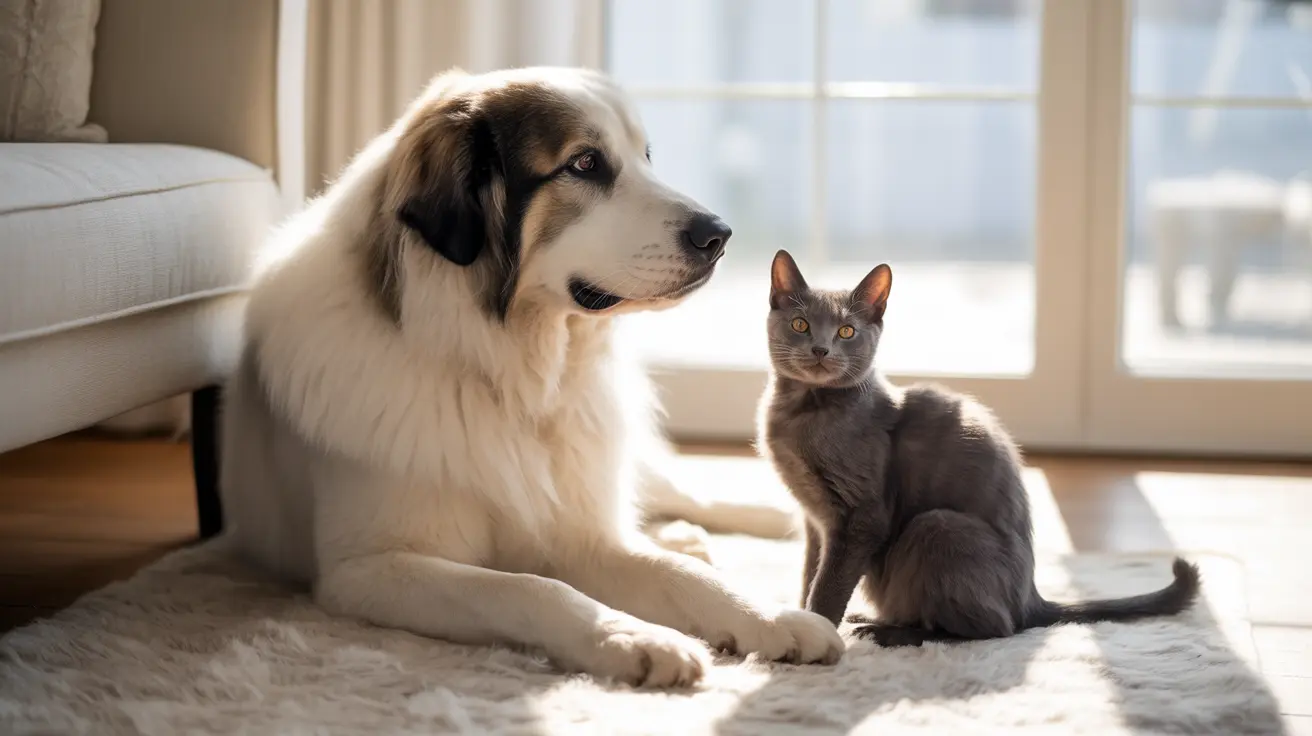Introduction
Are Great Pyrenees good with cats? This question often arises among pet owners considering adding this majestic breed to their feline-inclusive household. The good news is that Great Pyrenees typically demonstrate excellent compatibility with cats, thanks to their gentle nature and protective instincts inherited from their livestock guardian heritage. Understanding this unique breed's characteristics and implementing proper introduction techniques can lead to harmonious multi-pet relationships.
In this comprehensive guide, we'll explore the factors that make Great Pyrenees generally good companions for cats and provide essential tips for ensuring successful cohabitation between these diverse pets.
Understanding the Great Pyrenees Temperament
Great Pyrenees, originally bred as livestock guardians in the Pyrenees Mountains, possess an inherently gentle and protective nature. Their historical role required them to watch over vulnerable animals, making them naturally inclined to protect rather than chase smaller creatures. This guardian instinct often extends to household pets, including cats.
These "gentle giants" typically display remarkable patience and calm demeanor, characteristics that prove invaluable when sharing space with cats. Their low prey drive, compared to hunting breeds, makes them more likely to accept feline family members as part of their protected "flock."
Factors Affecting Cat Compatibility
Early Socialization
The most crucial factor in determining whether a Great Pyrenees will get along with cats is early socialization. Puppies exposed to cats during their critical development period (between 3-16 weeks) are more likely to develop positive associations with felines. However, even adult Pyrs can learn to coexist peacefully with cats through proper introduction and training.
Individual Personality
Each Great Pyrenees has a unique personality that influences their interaction with cats. While breed tendencies are generally favorable, individual dogs may show varying levels of interest in their feline housemates – from protective behavior to gentle indifference.
Creating a Successful Multi-Pet Household
Safe Space Management
Despite their typically gentle nature, Great Pyrenees' large size necessitates careful household management. Create elevated spaces and escape routes for cats, ensuring they have safe zones to retreat when needed. This might include cat trees, high shelves, or separate rooms accessible through cat doors.
Supervised Introduction Process
Begin introductions gradually, using barriers like baby gates to allow safe visual contact. Progress to controlled interactions under close supervision, rewarding calm behavior from both pets. This process may take weeks or months, depending on individual personalities.
Training and Management Tips
Establish clear boundaries and expectations for your Great Pyrenees from the start. Use positive reinforcement to reward gentle behavior around cats, and never punish curiosity or interest. Consistent training helps develop reliable responses and mutual respect between species.
Monitor all interactions initially, gradually increasing freedom as both pets demonstrate consistent appropriate behavior. Some Great Pyrenees may never require constant supervision around cats, while others might need ongoing management.
Frequently Asked Questions
Are Great Pyrenees dogs generally good with cats in the same household?
Yes, Great Pyrenees are typically good with cats due to their gentle nature and protective instincts. Their historical role as livestock guardians makes them more likely to protect rather than chase cats, especially when properly socialized.
How should I introduce a Great Pyrenees to my cat to ensure they get along?
Start with separate spaces, allowing them to become familiar with each other's scents. Use baby gates for visual introduction, then progress to supervised interactions in neutral territory. Always reward calm behavior and never force interactions.
What personality traits of Great Pyrenees influence their behavior around cats?
Their patient, calm demeanor and protective instincts make them naturally suited to living with cats. Their low prey drive and gentle nature typically result in peaceful coexistence with feline family members.
Can a Great Pyrenees accidentally harm a cat because of their size?
While unintentional harm is possible due to their large size, Great Pyrenees are generally careful and gentle with smaller animals. Proper supervision and training help minimize any risks of accidental injury.
What steps can I take to supervise and manage interactions between my Great Pyrenees and cat safely?
Maintain consistent supervision during initial interactions, provide escape routes for cats, use positive reinforcement training, and ensure both pets have their own space. Progress gradually based on both animals' comfort levels.
Conclusion
Great Pyrenees can make excellent companions for cats when proper introduction and management techniques are followed. Their natural protective instincts, combined with their gentle temperament, often result in successful multi-pet households. While individual results may vary, most Great Pyrenees can learn to live harmoniously with feline family members through patience, proper training, and careful management.






